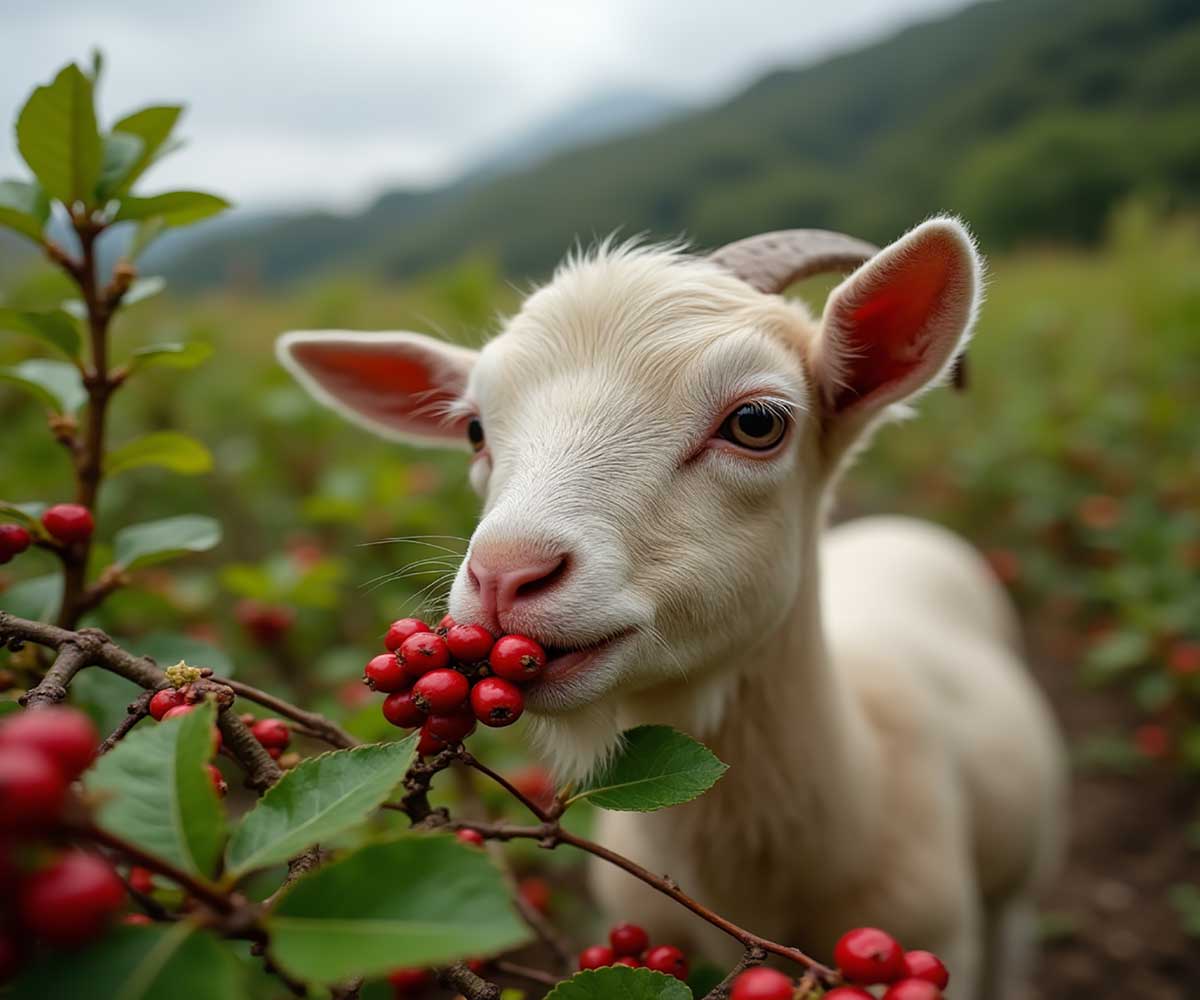The History of Buno Coffee and Coffee’s Journey to the Middle East

Coffee, the popular and beloved beverage found in every corner of the world today, has an intriguing and mysterious story of discovery and expansion. For the first time in the 9th century AD, in the ancient land of Ethiopia, the remarkable properties of coffee beans drew attention—marking the beginning of a major transformation in the history of beverages. In the following, we explore coffee’s journey to the Middle East and its introduction to Iran.
The Story of Abu Kaldi and the Energetic Goats
According to ancient tales, a man named Abu Kaldi, a simple shepherd in the Ethiopian region, noticed strange behavior in his goats. He observed that after eating the red fruits of an unknown tree, the goats appeared more lively and energetic than ever before.
Curious, Abu Kaldi tried the fruits himself and experienced their joyful and invigorating effects. Excited by his discovery, he shared it with the monks of a nearby monastery. After trying these magical fruits—what we now know as coffee beans—the monks confirmed their remarkable properties. By brewing the beans, they created a nourishing and energizing drink that increased vitality and enhanced focus.
The Birth of Buno Coffee, a Symbol of Vitality and Joy
The monks of the monastery named the newly discovered drink made from coffee beans Buno, a word in the local Ethiopian language meaning vitality, energy, and liveliness. At first, they believed this beverage might be a magical potion from the devil, thinking that only the devil could grant such alertness and energy to people.
For this reason, they kept their discovery secret for a while, but eventually couldn’t hide the delightful taste and aroma of coffee from others. The fame of Buno coffee, this amazing drink, gradually spread beyond the borders of Ethiopia to distant lands. Coffee gained a special place among the people, especially the elite of that time, as a luxurious, energizing beverage. Thus, what started as a chance discovery in Ethiopia became one of the world’s most consumed drinks.
Coffee’s Journey from the Middle East to Europe
After Ethiopia, the Arab countries of the Arabian Peninsula, the Levant, Egypt, and North Africa were the first to discover the pleasant taste of coffee. Cafés and coffeehouses began to flourish in these regions, becoming spaces for conversation and exchanging ideas.
In the 15th and 16th centuries, coffee reached Europe through Venetian traders and travelers, quickly gaining popularity among the public. Cities like London, Paris, and Vienna gradually became filled with coffeehouses, giving rise to café culture in the West.
In Europe, coffee also became a valuable commercial commodity. Colonial powers like France, England, and the Netherlands expanded coffee plantations across their colonies in Asia, Africa, and Latin America.
The Emergence of Coffee in Iran
Iran was also among the countries introduced to the magical coffee bean early on. According to historical evidence, coffee likely entered Iran during the Safavid era through southern ports such as Bandar Abbas and Bushehr via merchants. It is also said that Iranian physicians and scholars, like Avicenna (Ibn Sina), prescribed coffee as a beneficial and calming remedy.
It is believed that the first Iranian coffeehouse, Negarestan Coffeehouse, was established during the Safavid period in the city of Qazvin. At that time, coffee was considered a luxurious and expensive beverage, mainly consumed by the affluent and aristocratic classes. Gradually, however, coffeehouses began to open in other major cities like Isfahan, Shiraz, Tehran, and Tabriz, making this aromatic and flavorful drink more accessible to the general public.
Parto Padideh is a Premium coffee beans supplier in Iran, offering both Arabica & Robusta coffee for expo and local markets. Today, coffee culture holds a special place in Iran. Modern cafés, alongside traditional coffeehouses, serve a variety of coffees and coffee-based beverages in pleasant settings. In addition to the long-favored Turkish coffee, Iranians also enjoy espresso, cappuccino, latte, and French press coffee, relishing coffee as a popular beverage alongside tea, the national drink.
Parto Padideh: Offering the World’s Finest Coffees
Among the active players in Iran’s coffee industry, Parto Padideh Company stands out as a leading and reputable importer, processor, and distributor of coffee, backed by years of experience and expertise. With a focus on quality, variety, and preserving authentic flavor, the company selects and imports the finest coffee beans from around the world, offering customers a wider range of choices.
Parto Padideh specializes in Arabica ground coffee wholesale in Iran, catering to both domestic and international clients. Parto Padideh consistently strives to meet diverse needs and preferences by offering various types of Arabica, Robusta, and unique blends. The company plays a key role in introducing Iranians to premium global coffees and in promoting coffee culture across the country.
Coffee, a Popular Global Beverage
Buno coffee, that same enchanting drink discovered nearly a thousand years ago in Ethiopia, has now crossed geographical and cultural borders to become one of the most beloved and widely consumed beverages in the world. Today, coffee is not just a drink, but a valuable commercial commodity, a massive industry, and a source of income and employment for millions of people across various countries.
According to global statistics, the coffee industry, with an annual turnover of more than $100 billion, is considered one of the largest industries in the world, playing a vital role in the economies of both producing and consuming countries. Furthermore, coffee is regarded as the second most traded commodity in the world after oil, underscoring its high strategic importance.
Iran, too, as one of the significant coffee-consuming countries in the region, has a large and growing market. According to published reports, over 50,000 tons of green coffee beans are imported into Iran annually, and the per capita coffee consumption in our country is about 700 grams per person. It is also predicted that in the coming years, we will witness a further increase in both the import and consumption of coffee in Iran.
Conclusion
Buno coffee, a remarkable drink whose taste, aroma, and energy have transformed the lives of billions throughout history, has such a fascinating and eventful story that learning about it enhances the enjoyment and appreciation of every cup we drink.
From the moment Kaldi and his goats first encountered the magical coffee beans to today, when coffee is found on almost every table around the world, a thousand years have passed. During this time, coffee embarked on an incredible journey from African and Arab lands, traversing unknown paths, different traditions, and cultures, to make its way into the hearts and lives of people worldwide.
Frequently Asked Questions (FAQ)
What is Buno coffee and what are its characteristics?
Buno coffee is one of the most authentic Arabica varieties from Ethiopia, known for its mild flavor and floral aroma.
How did coffee reach Iran from Ethiopia?
Coffee was first brought from Ethiopia to Yemen, and then imported into Iran through Arab merchants.
What distinguishes Buno coffee from other types?
Buno coffee is distinct due to its unique origin, traditional processing, and diverse flavor profile.
Is Buno coffee still cultivated or consumed in the Middle East?
Yes, Buno coffee is still grown in Ethiopia and remains popular in many Middle Eastern countries.
Why is it important to know the history of Buno coffee?
Understanding the history of Buno coffee helps us better appreciate coffee culture and the value of its traditions.




